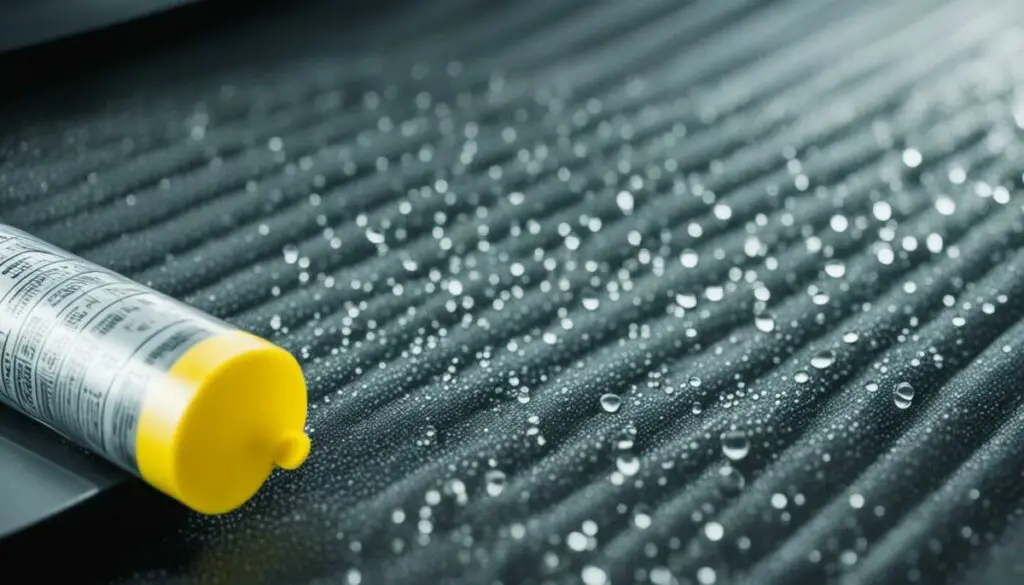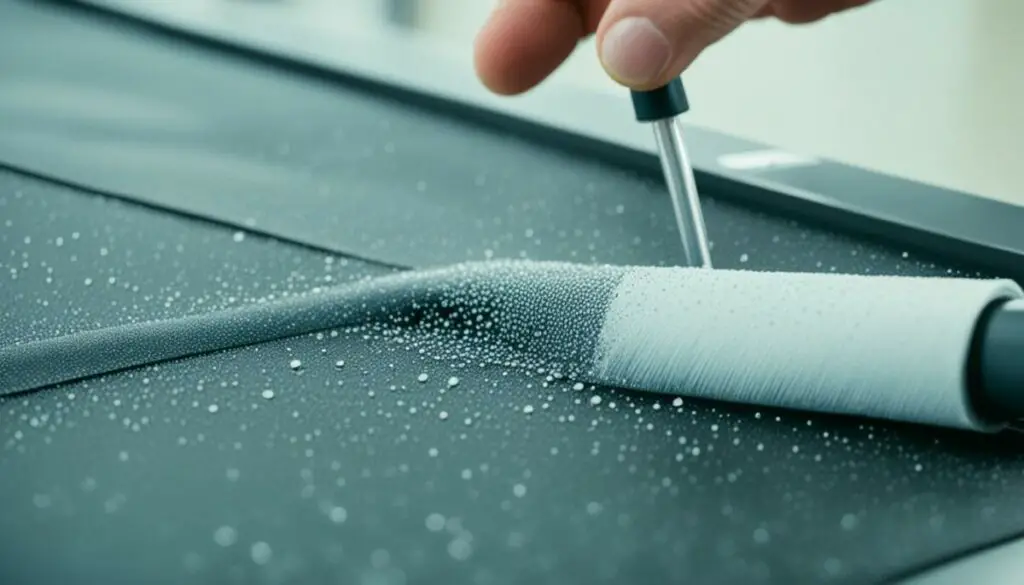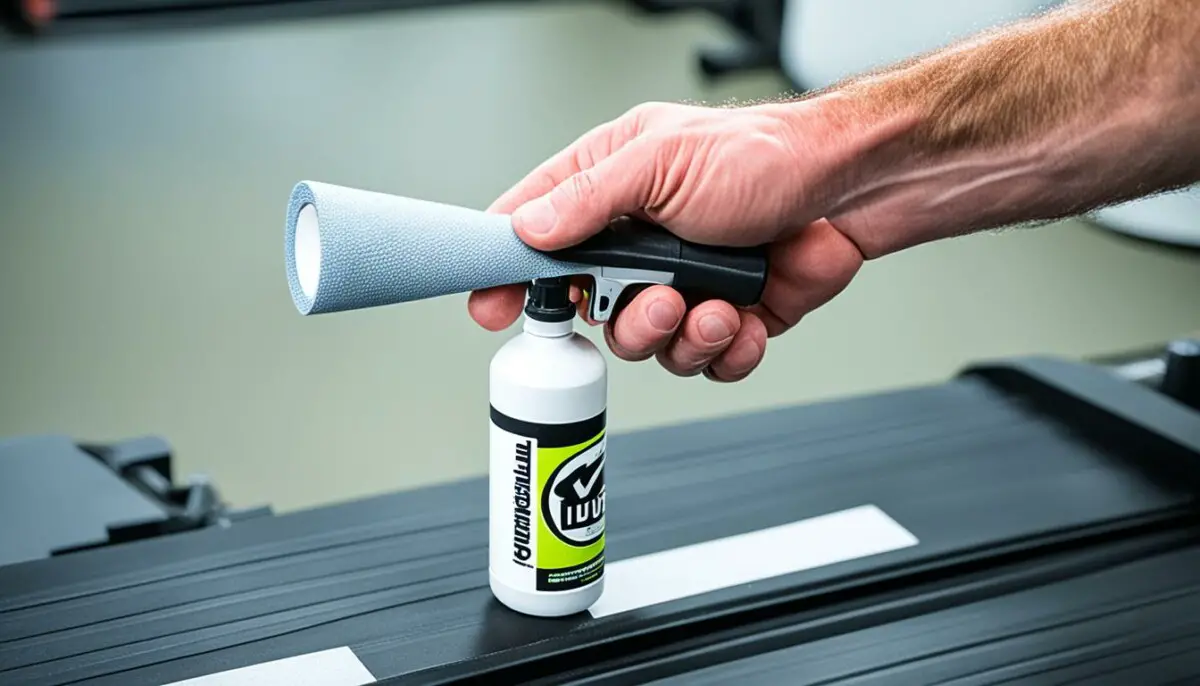Last Updated on 3 months by Francis
Treadmills are essential exercise equipment for fitness enthusiasts and gym owners. Regularly lubricating the treadmill belt is important to reduce friction, prevent damage, and improve performance. Follow these steps to properly lubricate your treadmill and ensure smooth running.
Contents
Key Takeaways:
- Regularly lubricating your treadmill belt is crucial for optimal performance and longevity.
- Use a high-quality silicone-based lubricant specifically designed for treadmills.
- Determine whether your treadmill needs lubrication by checking the manufacturer’s recommendations.
- Gather the necessary tools, including an allen wrench or screwdriver and a silicone-based lubricant.
- Follow a step-by-step guide to properly lubricate your treadmill belt.
Understanding the Importance of Treadmill Lubrication

Lubricating your treadmill belt is crucial for its optimal performance and longevity. Regular maintenance and lubrication help prevent premature wear and damage to the treadmill. By reducing friction between the belt and the walking deck, lubrication ensures smooth operation and extends the lifespan of your treadmill.
The key to effective treadmill lubrication is using the right lubricant. Look for a high-quality silicone-based lubricant specifically designed for treadmills. These lubricants provide excellent lubrication properties and minimize the risk of belt slippage, ensuring a safe and efficient workout experience.
Proper treadmill belt maintenance involves regular lubrication as recommended by the manufacturer. This can vary depending on usage and model, but a general guideline is to lubricate the treadmill every three months or after a certain number of miles walked. Checking your owner’s manual for specific instructions is recommended.
Here are some reasons why treadmill lubrication is essential:
- Reduces Friction: Lubrication creates a smooth surface between the belt and the deck, reducing friction and preventing excessive heat buildup. This reduces stress on the motor, prolonging its life.
- Prevents Belt Wear: A properly lubricated belt reduces wear and tear, protecting it from damage and extending its lifespan. This reduces the frequency of belt replacement, saving you money in the long run.
- Ensures Smooth Operation: Lubrication enhances the movement of the belt, providing a seamless and comfortable workout experience. It prevents belt slippage and uneven movements, allowing you to maintain a consistent pace and stride.
- Quiets Noisy Treadmills: If your treadmill has started making squeaking or squealing noises, it’s likely due to inadequate lubrication. Regular lubrication eliminates these noises, ensuring a peaceful and enjoyable exercise session.
Proper lubrication is essential to maintain the health and performance of your treadmill. By following a regular maintenance routine and using the best treadmill lubricant, you can ensure a smooth and efficient workout experience for years to come.
For a visual guide on treadmill lubrication, refer to the table below:
| Step | Description |
|---|---|
| Step 1 | Turn off and unplug your treadmill for safety. |
| Step 2 | Expose the deck by loosening the rear roller bolts. |
| Step 3 | Wipe away dirt and dust from beneath the walking belt. |
| Step 4 | Apply the silicone-based lubricant in a zig-zag motion between the belt and the deck. |
| Step 5 | Lower the belt to the center of the deck and tighten the rear roller bolts. |
| Step 6 | Start the treadmill and let it run at a slow speed to spread the lubricant. |
| Step 7 | Wipe off any excess lubricant on the side rails with a soft cloth. |
Regular lubrication is key to ensuring the longevity and performance of your treadmill. By understanding the importance of treadmill lubrication and following the recommended maintenance schedule, you can enjoy smooth and hassle-free workouts for years to come.
Does Your Treadmill Need Lubrication?

Regular lubrication is crucial for maintaining the performance and longevity of your treadmill. To determine whether your treadmill needs lubrication, refer to the manufacturer’s recommendations in the owner’s manual. It will provide you with the appropriate lubrication schedule based on the model and usage.
Most treadmills require lubrication every three months or after a certain number of miles walked. Adhering to this schedule will help keep your treadmill running smoothly and prevent unnecessary wear and tear. Neglecting to lubricate your treadmill can result in a lack of a waxy oily surface or any residue, slow belt movement, slipping, or increased noise during operation.
Pay attention to the signs that indicate your treadmill needs lubrication. If you notice any of these issues, it’s time to lubricate the treadmill belt to ensure optimal performance. Regular lubrication not only reduces friction but also extends the lifespan of your treadmill, saving you from costly repairs in the long run.
Now that you know the importance of treadmill lubrication and how to identify when it’s needed, let’s move on to the next section to learn about the tools required for treadmill lubrication.
Gentle Reminder:
Regular lubrication is crucial for maintaining the performance and longevity of your treadmill.
Gathering the Tools for Treadmill Lubrication

Before you start lubricating your treadmill, make sure you have the necessary tools and lubricant on hand. Here’s what you’ll need:
- An allen wrench, t-wrench, or screwdriver (as specified in your owner’s manual) to loosen and adjust the treadmill parts.
- A high-quality silicone-based treadmill lubricant, specifically designed for treadmills. This type of lubricant provides excellent lubrication and prevents the buildup of dirt and debris.
It’s important to use a lubricant that is recommended by your treadmill manufacturer or a fitness equipment store. They can guide you in selecting the right lubricant for your specific treadmill model. Using the wrong lubricant may damage your treadmill and void any warranties.
Now that you have all the necessary tools and lubricant ready, you’re prepared to lubricate your treadmill and ensure its smooth operation.
Step-by-Step Guide to Lubricating Your Treadmill Belt

Properly lubricating your treadmill belt is crucial for maintaining its performance and extending its lifespan. Follow these simple steps to ensure smooth operation:
- Turn off and unplug your treadmill: Before starting the lubrication process, make sure your treadmill is turned off and unplugged to ensure safety.
- Expose the deck: Use an allen wrench or screwdriver to loosen the rear roller bolts and lift the walking belt to expose the deck.
- Clean the surface: Wipe away any dirt or dust from beneath the walking belt using a clean cloth. This step ensures optimal lubrication.
- Apply the lubricant: Using a high-quality, silicone-based lubricant specifically designed for treadmills, apply it in a zig-zag motion between the walking belt and the flat running deck surface. This ensures even distribution of the lubricant.
- Lower the belt and tighten the bolts: Lower the walking belt back to the center of the deck and tighten the rear roller bolts to secure it in place. This ensures proper tension and alignment.
- Start the treadmill: Turn on the treadmill and let it run at a slow speed for a few minutes. This allows the lubricant to spread evenly across the belt and reduces friction.
- Remove excess lubricant: Use a soft cloth to gently wipe off any excess lubricant on the side rails. This prevents any residue from accumulating and staining your workout clothes.
Tips:
- Refer to your treadmill’s owner’s manual for specific instructions on lubrication and any recommended lubricants.
- Follow the manufacturer’s recommended lubrication schedule, typically every three months or after a certain number of miles walked.
- Regularly clean and maintain your treadmill to ensure optimal performance and longevity.
- Consider using a treadmill mat underneath your treadmill to protect the floor and reduce dust accumulation.
By following this step-by-step guide, you can effectively lubricate your treadmill belt and enjoy a smooth, quiet, and hassle-free workout experience.
Additional Tips for Treadmill Maintenance
In addition to regular lubrication, there are several other tips and practices that you should follow to keep your treadmill in top condition. By incorporating these maintenance tasks into your routine, you can ensure the longevity and optimal performance of your treadmill.
Clean the Treadmill Regularly
Regular cleaning is essential to remove dirt, dust, and debris from your treadmill. Use a soft cloth or mild cleaning solution to wipe down the console, handrails, and other surfaces. Pay special attention to the belt, deck, and motor area, removing any accumulated dust or particles. Keeping your treadmill clean not only improves its appearance but also prevents significant disruptions in its performance.
Inspect the Belt for Signs of Wear
Regularly inspect the treadmill belt for any signs of wear and tear. Look for fraying edges, cuts, or areas of excessive wear in the middle or sides of the belt. If you notice any signs of damage, it’s important to address them promptly to prevent further deterioration. Adjust the tension of the belt as necessary to ensure it remains taut and properly aligned.
Check the Belt Alignment
Proper alignment of the treadmill belt is crucial for smooth and safe operation. Misaligned belts can cause uneven wear, increased friction, and even accidents. Periodically check the belt alignment and make any necessary adjustments. Consult your treadmill’s manual for guidance on how to align the belt correctly.
Keep the Area Around the Treadmill Clean and Clutter-Free
Ensure that the space surrounding your treadmill is clean, clear, and free from any obstructions. Leaving objects or clutter near the treadmill can pose safety hazards and may interfere with its functioning. Create a dedicated workout space, keeping the area around the treadmill free from fitness equipment, furniture, or other objects.
Follow the Manufacturer’s Recommendations
Every treadmill model comes with specific maintenance recommendations from the manufacturer. It’s important to follow these guidelines to ensure the longevity and performance of your treadmill. These recommendations may include lubrication schedules, servicing instructions, and other tips for optimal maintenance. Refer to your treadmill’s manual or contact the manufacturer for detailed instructions.
By incorporating these additional maintenance tips into your routine, you can keep your treadmill in excellent condition and enjoy smooth, safe workouts for years to come.
| Maintenance Task | Frequency |
|---|---|
| Cleaning the treadmill surfaces and belt | Weekly |
| Inspecting the belt for wear and tear | Monthly |
| Checking and adjusting belt tension | Monthly |
| Aligning the belt | Every 3 months |
| Clearing the area around the treadmill | Ongoing |
Following this maintenance checklist will help you stay on top of your treadmill’s upkeep, ensuring that it continues to perform optimally and providing you with a safe and enjoyable workout experience.
Get Expert Assistance for Treadmill Care
If you’re unsure about how to lubricate your treadmill or need further assistance with treadmill maintenance, it’s always best to consult with experts. Reach out to fitness equipment stores or consult with treadmill manufacturers for guidance. They can provide recommendations on the best lubricants for your treadmill and offer expert advice on maintenance and care.
When it comes to the proper lubrication and maintenance of your treadmill, seeking expert assistance is crucial. Professionals in the industry have the knowledge and expertise to ensure that your treadmill is well-maintained and performs optimally.
Treadmill manufacturers are a valuable source of information. They have extensive knowledge about their own treadmills and can provide specific recommendations for lubrication and maintenance. Contacting the customer support or technical service department of your treadmill’s manufacturer will give you access to expert advice and guidance tailored to your specific treadmill model.
Another valuable resource for treadmill care is fitness equipment stores. These stores specialize in exercise equipment and have trained professionals who can offer guidance on treadmill maintenance. They can help you select the best lubricant for your treadmill and provide step-by-step instructions on proper lubrication.
By seeking expert assistance, you can ensure that you are using the correct lubricant for your treadmill and following the proper maintenance procedures. This will help you avoid potential issues and keep your treadmill in optimal condition for long-term use.
Remember, maintaining a regular lubrication schedule and following the manufacturer’s recommendations for maintenance will prolong the lifespan of your treadmill and ensure smooth and safe operation.
Expert Tips:
“Always refer to your treadmill’s owner’s manual for specific lubrication instructions and recommendations.”
“If you notice any unusual noises or decreased performance, it’s important to seek professional assistance to diagnose and address the issue.”
“Regular lubrication is a preventative measure that can save you from costly repairs and extend the life of your treadmill.”
Importance of Regular Treadmill Maintenance
Regular maintenance is crucial for maximizing the lifespan and performance of your treadmill. By following a proper maintenance routine, including regular lubrication, you can prevent costly repairs and ensure smooth operation. Taking care of your treadmill will extend its longevity and ensure a safe and effective workout experience.
Why Maintenance Matters
Just like any other piece of machinery, treadmills require regular maintenance to perform at their best. Without proper care, the treadmill belt can become worn, leading to decreased performance, excessive noise, and even potential safety hazards. Regular maintenance tasks, such as lubrication, can keep the treadmill running smoothly and reduce the risk of costly repairs or replacement parts.
Benefits of Regular Lubrication
Lubricating the treadmill belt is a critical part of its maintenance. The lubricant creates a barrier between the belt and the deck, reducing friction and minimizing wear. This not only extends the life of the belt but also enhances performance by allowing for smoother movement. Regular lubrication ensures that the treadmill operates quietly and efficiently, providing a comfortable workout experience.
Proper lubrication can significantly improve the treadmill’s performance and minimize the risk of unnecessary wear and tear. Regular maintenance, including lubrication, is key to maximizing the lifespan of your treadmill and ensuring a safe and effective workout.
Maintenance Checklist
To keep your treadmill in optimal condition, consider the following maintenance checklist:
- Refer to the owner’s manual for manufacturer guidelines on maintenance and lubrication.
- Check the treadmill belt regularly for signs of wear and tear.
- Wipe down the treadmill after each use to remove sweat and debris.
- Lubricate the treadmill belt as recommended by the manufacturer.
- Inspect the treadmill for loose screws or bolts and tighten them if necessary.
By following these maintenance steps, you can ensure that your treadmill remains in excellent condition and provides a smooth and enjoyable workout experience.
Expert Assistance
If you’re unsure about how to properly maintain your treadmill or need further assistance, don’t hesitate to consult with experts. Reach out to fitness equipment stores or contact the treadmill manufacturer for guidance and support. They can provide you with the best information on treadmill maintenance, including lubrication techniques and recommended lubricants for your specific treadmill model.
Conclusion
Properly maintaining and lubricating your treadmill is crucial for its optimal performance and longevity. By following the step-by-step guide outlined in this article, you can ensure that your treadmill runs smoothly and prevents unnecessary wear and tear. Regular lubrication, as part of your treadmill belt maintenance routine, will reduce friction and extend the lifespan of your equipment.
Remember to consult your treadmill’s owner’s manual for specific instructions and recommendations from the manufacturer. It’s important to use a high-quality treadmill lubricant that is approved for your specific model. When in doubt, you can always seek expert assistance from fitness equipment stores or contact the treadmill manufacturer for further guidance on lubrication and maintenance.
By taking care of your treadmill and following a regular maintenance schedule, you can enjoy a safe and effective workout experience for years to come. So, don’t overlook the importance of proper lubrication and maintenance for your treadmill. Start implementing these practices today and keep your treadmill running smoothly for all your fitness needs!
FAQ
Why is it important to lubricate a treadmill?
Lubricating a treadmill belt reduces friction, prevents damage, and improves performance. It helps extend the lifespan of the treadmill and ensures smooth running.
How often should I lubricate my treadmill?
The frequency of treadmill lubrication depends on the manufacturer’s recommendations. Most treadmills need to be lubricated every three months or after a certain number of miles walked.
How can I tell if my treadmill needs lubrication?
Signs that your treadmill needs lubrication include a lack of a waxy oily surface or any residue, slow belt movement, slipping, or increased noise during operation.
What tools do I need to lubricate my treadmill?
You will typically need an allen wrench, t-wrench, or screwdriver, as specified in your owner’s manual. You’ll also need a silicone-based treadmill lubricant specifically designed for treadmills.
How do I lubricate my treadmill belt?
Step 1: Turn off and unplug the treadmill for safety. Step 2: Expose the deck by loosening the rear roller bolts. Step 3: Wipe away dirt and dust from beneath the walking belt. Step 4: Apply the silicone-based lubricant in a zig-zag motion between the belt and the running deck. Step 5: Lower the belt and tighten the rear roller bolts. Step 6: Start the treadmill and let it run at a slow speed for a few minutes to spread the lubricant. Step 7: Wipe off excess lubricant on the side rails with a cloth.
What other maintenance tips should I follow for my treadmill?
Clean the treadmill regularly, inspect the belt for wear, adjust belt tension if necessary, keep the area around the treadmill clean, and follow the manufacturer’s recommendations for maintenance and servicing.
What should I do if I need assistance with my treadmill maintenance?
It is best to consult with experts such as fitness equipment stores or treadmill manufacturers. They can provide recommendations on lubricants and offer expert advice on maintenance and care.
Why is regular treadmill maintenance important?
Regular maintenance, including lubrication, helps maximize the lifespan and performance of the treadmill. It prevents costly repairs and ensures a safe and effective workout experience.
What is the importance of proper treadmill lubrication?
Proper lubrication keeps the treadmill running smoothly, reduces wear and tear, and extends the lifespan of the equipment.





.jpg)


